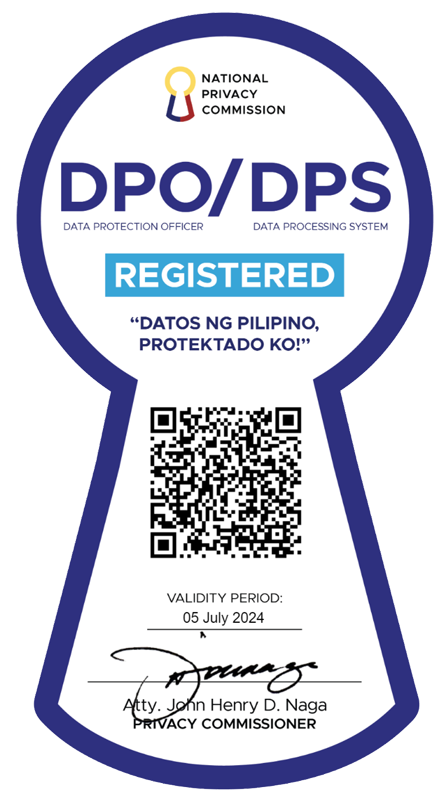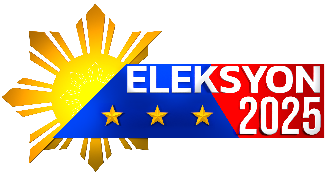Race to the Presidency: Where did all the candidates go?
With over 7,000 islands, hopping from one province to another in the Philippines is no easy task. Anyone who seeks the presidency must carefully strategize which areas to visit, which to revisit, and which to bypass entirely.
As the campaign period comes to a close, we look back at the journey of the five presidential candidates.
GMA News mapped each candidate’s campaign history by using a proprietary campaign tracker developed in cooperation with AMA Education System. The tracker uses an algorithm that takes advantage of Twitter’s geotagging feature and other parameters to help curate photos and tweets related to campaign activities.
The tracker is a robust and generally reliable tool, but limited to crowd-sourced data and may need a little further vetting—either by contacting a candidate’s campaign team or a simple Google search to confirm independent sightings.
To further make sense of this wealth of information, we compared these to COMELEC data on registered voters per province; poverty statistics from the Philippine Statistics Authority (PSA); and candidates’ campaign history.
Political Destinations
The heat map generated by the campaign tracker shows that Vice President Jejomar Binay, Senator Grace Poe, former Interior Secretary Mar Roxas, Senator Miriam Defensor-Santiago, and Davao City Mayor Rodrigo Duterte spent the most time visiting vote-rich areas.
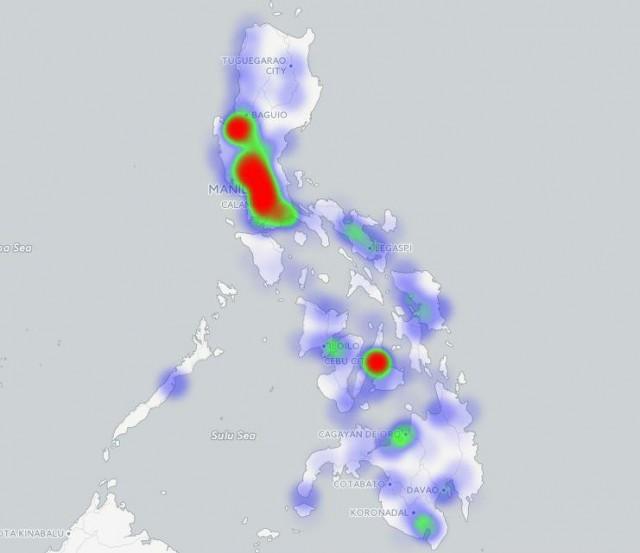 A heat map of the campaign trail, from the GMA-AMA Campaign Tracker. Blue-colored areas were visited once, red-colored areas visited multiple times.
A heat map of the campaign trail, from the GMA-AMA Campaign Tracker. Blue-colored areas were visited once, red-colored areas visited multiple times.All these candidates held the most sorties and other campaign activities in the National Capital Region (NCR): Duterte, no less than 12; Poe, 11 times; Roxas, 10; Binay, 8,;and Santiago, 3.
It’s worth noting that the NCR has over 6 million registered voters according to COMELEC data.
The heat map also indicates that Cebu, Cavite, Pangasinan, Laguna, Negros Occidental, Bulacan, Batangas, Rizal, Nueva Ecija, and Pampanga were important destinations. These areas are consistently in the list of vote-rich provinces that promise no less than a million votes.
Interestingly, the campaign tracker did not catch any social media activity confirming Binay’s visiting Negros Occidental and IloIlo. His campaign team, however, disputes this.
Data also shows that Santiago and Poe did not visit Davao del Sur. Santiago also skipped Leyte. Santiago’s camp confirmed these findings, but we have yet to hear from Poe’s camp as of posting time.
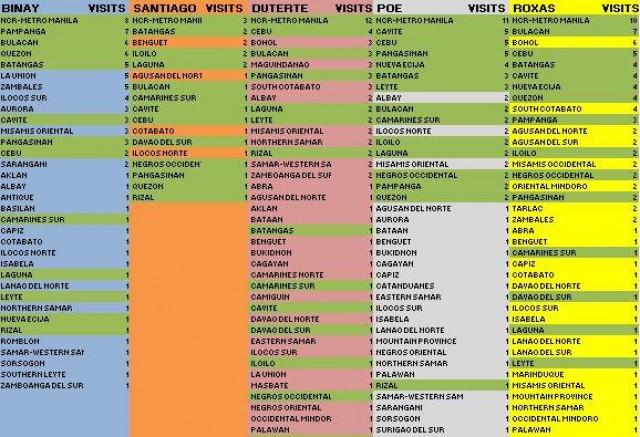 Areas frequently visited by presidential candidates. Vote-rich areas shown in green.
Areas frequently visited by presidential candidates. Vote-rich areas shown in green.
According to UP political scientist Dr. Aries Arugay, this movement pattern is not really much of a surprise, since candidates are well aware of the votes at stake in these areas.
“[Candidates] don’t need the majority vote, they only need plurality. Given limited resources, candidates are expected to [visit those areas],” Arugay explained.
Arugay also said that personally visiting and swaying the provinces in the Lingayen-Lucban corridor has historically been a key trend in winning the presidency. “[Voters] appreciate politicians that come to their place, given the geographic challenges (of how difficult it is to go there),” Arugay said.
Vote rich, low voter turnout?
But voter density doesn't necessarily translate into voter turnout. Although some areas have the numbers, they may not necessarily hold sway in the national elections. COMELEC data from 2001-2013 analyzed by GMA News Research show that Davao del Sur, Rizal, and Cavite have historically shown low voter turnout.
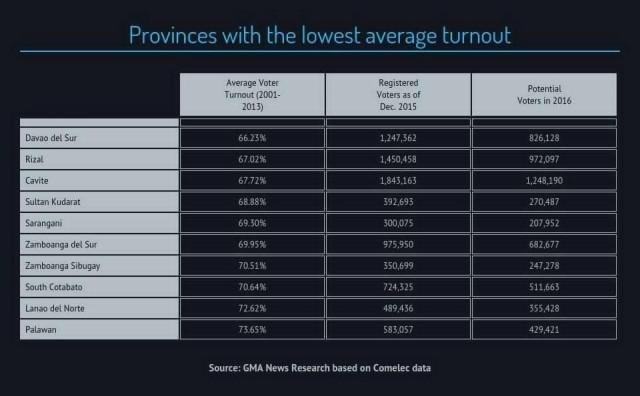
However, Davao del Sur’s turnout is expected to increase, thanks to Duterte's candidacy.
All candidates visited Cavite at least once during the campaign period.
The campaign tracker was unable to catch Roxas visiting Rizal during the campaign period. He was, however, able to visit in February, a month before the official start of the campaign season.
Poe and Binay both did not visit Davao del Sur, although we have yet to get confirmation from their camps on the accuracy of crowdsourced data.
Vote-poor areas
Comparing tracker data to COMELEC’s data on provinces that have a low number of registered voters, it appears that the candidates generally did not waste their time on vote-poor provinces.
None of them visited Batanes, Apayao, Siquijor, Dinagat Islands, Quirino, Guimaras, Biliran, Ifugao, Kalinga, Davao Occidental and Tawi-Tawi.
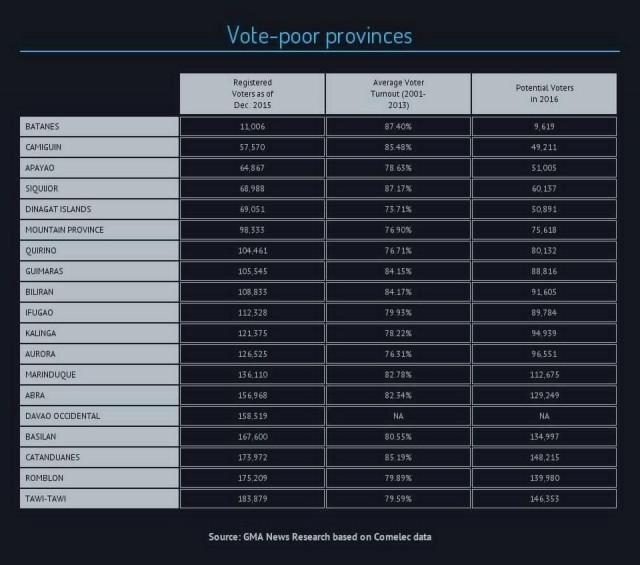
However, Binay was able to visit Basilan and Romblon. Duterte is the only candidate that visited Camiguin and Maguindanao. Poe is the lone candidate to visit Catanduanes. Roxas was able to visit Marinduque. Santiago did not visit any of the vote-poor provinces.
This is an interesting phenomenon, because vote-poor areas historically have high voter turnout. Areas that were not visited by candidates have a voter turnout of at least 78%. Batanes, for instance, may only have around 9,619 potential voters, but has an average voter turnout of 87.4%.
Dr. Arugay emphasized the role of political allies and machinery in areas where a candidate is unable to personally visit. Political ads also make up to this deficiency. According to surveys by Social Weather Station (SWS), some 60% of voters rely on political ads and TV reports for information on particular candidates.
Poor provinces
Presidential candidates were also able to visit a decent number of poor provinces.
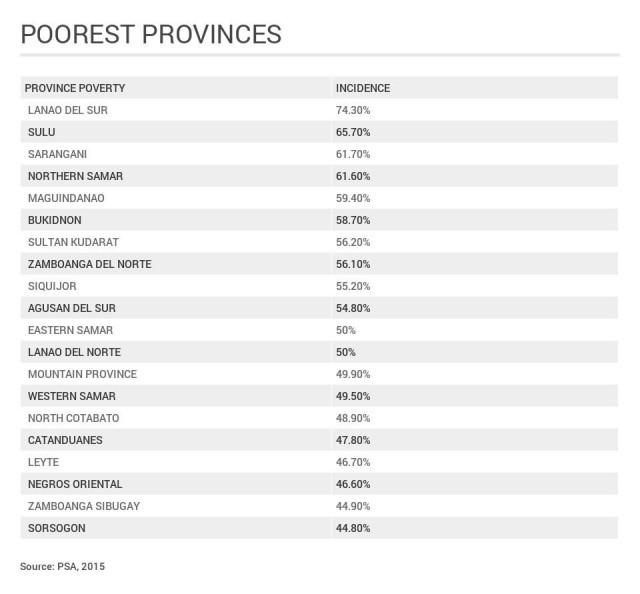
Poe was able to visit 11, while Roxas visited 10; Duterte and Binay tied with 8; and Santiago was able to visit five.
However, none of the candidates visited Siquijor and Sulu, according to tracker data. This is important to note because both provinces are among the top ten poorest in the country: Siquijor is in 9th place with a poverty incidence of 55.2%, while Sulu is in third place with 65.7% poverty incidence.
Incidentally, Siquijor is also a vote-poor province with only 68,988 registered voters, but with a high turnout rate of 87.17%.
Dr. Arugay said that the votes delivered by a province to a candidate may have several implications on its development. Politicians may have “discipline and punish tendencies,” with winning candidates tending to pour more resources into those areas that propelled him to the seat of power.
Role of Vice Presidential Candidates
Political tandems do not always visit an area together, preferring to each visit different places so as to cover more ground.
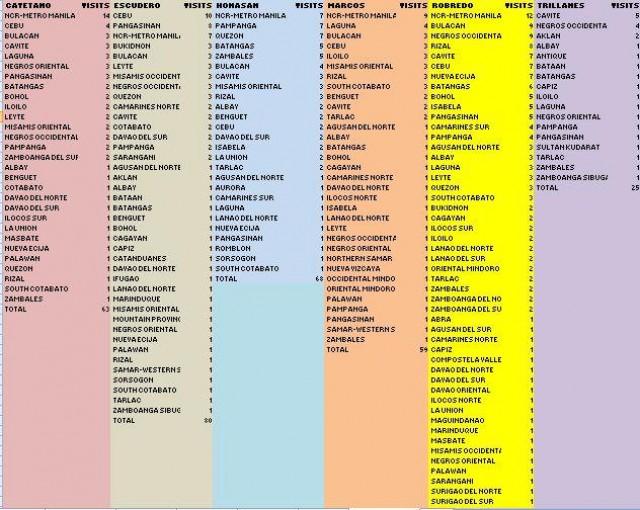
Among all vice presidential candidates, representative Leni Robredo made 147 separate visits to 51 provinces, as compared to Roxas with only 94 visits in 46 provinces.
Poe and her running mate, Senator Francis Escudero, had almost identical itnieraries throughout the campaign period, both vmaking 80 visits to 44 and 42 provinces, respectively.
Meanwhile, senator Gringo Honasan racked up 68 visits to 28 provinces, falling 14 visits short of Binay's record of 82 visits to 36 provinces.
Senator Alan Cayetano also had fewer visits than Duterte: the former was able to reach 31 provinces 63 times, whereas the latter campaigned 74 times in 43 provinces.
Senator Sonny Trillanes had the least number of campaign activities among the vice presidential candidates, with only 25 visits to 19 provinces. — TJD, GMA News
